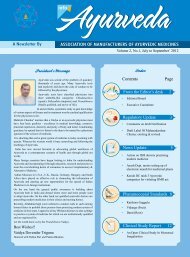Issue 12 - amam-ayurveda.org
Issue 12 - amam-ayurveda.org
Issue 12 - amam-ayurveda.org
Create successful ePaper yourself
Turn your PDF publications into a flip-book with our unique Google optimized e-Paper software.
FORMULATION COMPOSITION:<br />
1. Patha API Cissampelos pareira Rt. 1 part<br />
2. Jambu -bija majja API Syzygium cumini Enm. 1 part<br />
3. Amra-bija majja API Mangifera indica Enm. 1 part<br />
4. Shilabheda (Pashanabheda API) Bergenia ligulata Rz. 1 part<br />
5. Rasanjana API Berberis aristata Rt./St. Ext. 1 part<br />
6. Ambashthaki API Hibiscus sabdariffa Rt. 1 part<br />
7. Mocarasa (Shalmali) Salmalia malabarica Exd. 1 part<br />
8. Samanga (Lajjalu) API Mimosa pudica Rt./Pl. 1 part<br />
9. Padma kesara (Kamala) Nelumbo nucifera Adr. 1 part<br />
10. Vahlika (Kumkuma API) Crocus sativus Stl./Stg. 1 part<br />
11. Ativisha API Aconitum heterophyllum Rt. Tr. 1 part<br />
<strong>12</strong>. Musta API Cyperus rotundus Rf.Tr. 1 part<br />
13. Bilva API Aegle marmelos Rt./St.Bk. 1 part<br />
14. Lodhra API Symplocos racemosa St.Bk. 1 part<br />
15. Gairika (Shuddha) API Red ochre 1 part<br />
16. Katphala API Myrica nagi (M. esculenta) St. Bk. 1 part<br />
17. Marica API Piper nigrum Fr. 1 part<br />
18. Shunthi API Zingiber officinale Rz. 1 part<br />
19. Mridvika (Draksha API) Vitis vinifera Dr. Fr. 1 part<br />
20. Rakta candana API Pterocarpus santalinus Ht. Wd. 1 part<br />
21. Katvanga (Araluka API) Ailanthus excelsa St. Bk. 1 part<br />
22. Vatsaka (Kutaja API) Holarrhena antidysenterica St. Bk. 1 part<br />
23. Ananta (Shveta sariva API) Hemidesmus indicus Rt 1 part<br />
24. Dhataki API Woodfordia fruticosa Fl. 1 part<br />
25. Madhuka (Yasti API) Glycyrrhiza glabra Rt. 1 part<br />
26. Arjuna API Terminalia arjuna St. Bk. 1 part<br />
Method of preparation:<br />
Take all the ingredients of pharmacopoeial quality.<br />
Treat Gairika (No. 15) to prepare Shuddha Gairika (Appendix 6.2.7.2.),<br />
powder and pass through sieve number 85. Clean, dry and powder<br />
ingredients numbered 1 to 26 individually (except 15) and pass through<br />
sieve number 85. Weigh separately each powdered ingredient and mix<br />
together in specified ratio. Pass through sieve number 44 to prepare a<br />
homogeneous blend.<br />
Pack it in tightly closed containers to protect from light and moisture.<br />
Description:<br />
Reddish brown-coloured fine powder with a pungent odour and a bitter,<br />
sweet taste. The powder completely pass on through sieve number 44 and<br />
not less than 50 per cent pass on through sieve number 85.<br />
Identification<br />
Thin Layer Chromatography:<br />
Pharmocopial Standards For Pushyanuga Churna<br />
Extract 4 g of churna in alcohol (25 ml x 3) under reflux on a waterbath<br />
for 30 min filter, concentrate to 10 ml and carry out the thin layer<br />
chromatography. Apply 10 μl of the extract on TLC plate and develop the<br />
plate to a distance of 8 cm using toluene : ethyl acetate (5 : 2) as mobile<br />
phase. After development, allow the plate, to dry in air and examine under<br />
ultraviolet light (366 nm). It shows major spots at Rf 0.18 (blue), 0.73<br />
info Ayurveda, Volume 1, No.<strong>12</strong>, April-June’ 20<strong>12</strong><br />
PUSHYANUGA CHURNA<br />
(API PART II, VOL.I, PG.55-56)<br />
DEFINITION:Pushyanuga Churan is a powder preparation made with the ingredients in the Formulation composition given below<br />
(fluorescent blue). Spray the plate with vanillin-sulphuric acid reagent<br />
followed by heating at 1100 for about 10 min and observe under visible<br />
light. The plate shows major spots at Rf 0.13 (grey), 0.27 (purple), 0.33<br />
(yellow), 0.53 (purple), 0.66 and 0.97 (both purple).<br />
Physico-chemical parameters:<br />
Loss on drying at 105 degree: Not more than 11 per cent,<br />
Total ash: Not more than 15 per cent,<br />
Acid-Insoluble ash: Not more than 4 per cent,<br />
Alcohol-soluble extractive: Not less than <strong>12</strong> per cent,<br />
Water-soluble extractive: Not less than 13 per cent,<br />
pH (10% )aqueous solution: 5 to 6,<br />
Other requirements:<br />
Microbial limit: As in Appendix 2.4 of the book.<br />
Aflatoxin: As in Appendix 2.7 of the book.<br />
Storage: Store in a cool place in tightly closed containers, protected from<br />
light and moisture.<br />
Therapeutic uses: Asrigdhara (Menorrhagia), Shvetapradara<br />
(Leucorrhoea), Rajodosha (Menstrual disorder), Arsha (Piles), Yonidosha<br />
(disorders of female genital tract).<br />
Dose: 6 g daily in divided dose.<br />
Anupana: Milk or Tandulodaka.<br />
10


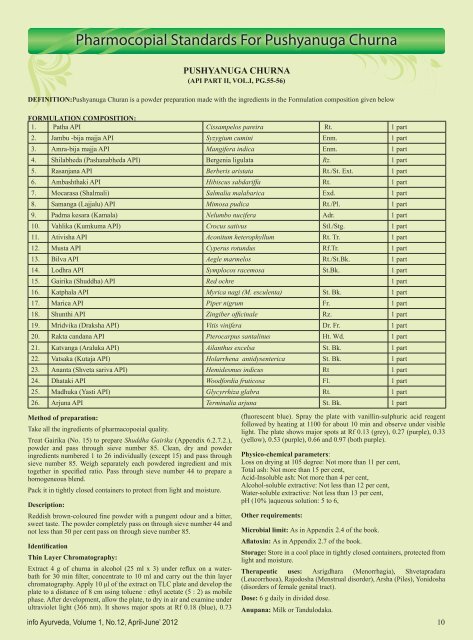

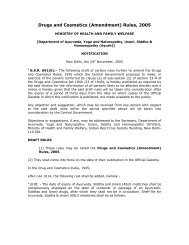
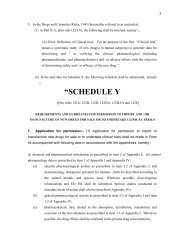
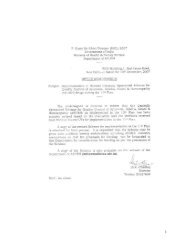

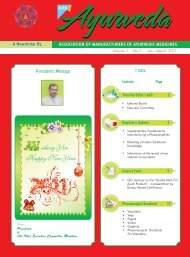

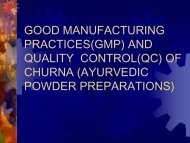
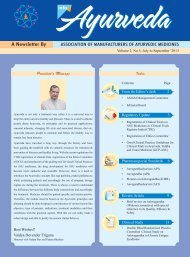
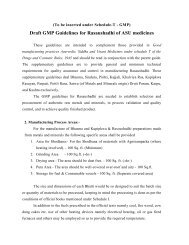
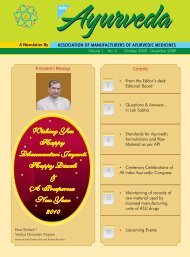
![[To be published in Gazette of India Part II Section 3, sub-section iii]](https://img.yumpu.com/28570283/1/190x245/to-be-published-in-gazette-of-india-part-ii-section-3-sub-section-iii.jpg?quality=85)

